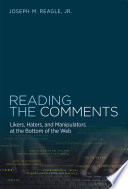

Online comments serve as a digital forum where users express opinions, share experiences, and engage in discussions. This idea explores how comments can shape public perception and influence decision-making. Comments can be a reflection of societal values and trends, showcasing the collective consciousness of the online community. They can also provide insights into consumer behavior, revealing what people appreciate or criticize about products and services. Understanding the nuances of online comments is crucial for businesses and marketers, as they can gauge audience sentiment and adapt strategies accordingly.
Continue readingThe motivations behind why people leave comments can be complex and varied. This idea delves into the psychological aspects of commenting, including the desire for validation, the need to belong, and the urge to express dissent. It examines how anonymity can embolden individuals to voice opinions they might otherwise keep private. The book discusses the implications of this behavior on online discourse, highlighting both positive contributions and toxic interactions. Understanding these psychological drivers can help platforms foster healthier environments for discussion.
Continue readingModeration of online comments is essential to maintain a constructive dialogue, but it comes with significant challenges. This idea addresses the balance between free speech and the need to curb harmful behavior. The book outlines various moderation strategies, from automated filters to human moderators, and discusses their effectiveness and limitations. It emphasizes the importance of creating guidelines that encourage respectful interactions while also protecting the platform's integrity. The challenges of moderation are compounded by the sheer volume of comments and the diversity of opinions, making it a critical area for ongoing research and development.
Continue readingAlgorithms play a crucial role in determining which comments are seen by users. This idea explores how algorithmic curation can shape conversations and influence public opinion. The book discusses the implications of algorithm-driven visibility, including the potential for echo chambers and the marginalization of dissenting voices. It raises important questions about transparency in algorithm design and the responsibility of platforms to ensure balanced representation of opinions. By understanding how algorithms function, users can become more critical consumers of online content.
Continue readingOnline comments can significantly impact a brand's reputation. This idea examines how consumer feedback in the comments section can either enhance or damage a brand's image. The book provides case studies of brands that have successfully engaged with comments to improve customer relations and those that have suffered due to negative feedback. It stresses the importance of monitoring comments and responding appropriately to foster positive brand perception. Brands that actively participate in the conversation are more likely to build trust and loyalty among their audience.
Continue readingThe cultural context in which comments are made can greatly influence their content and tone. This idea explores how cultural norms and values shape online discourse across different regions and demographics. The book highlights the importance of understanding these cultural differences for businesses operating in a global market. It discusses how comments can reflect broader societal issues and how brands can navigate these complexities to communicate effectively with diverse audiences. Recognizing the cultural nuances of commenting can lead to more meaningful engagement.
Continue readingThe future of online comments and discourse is rapidly evolving with advancements in technology and shifts in societal attitudes. This idea speculates on potential developments, such as the integration of AI in comment moderation and the rise of decentralized platforms. The book encourages readers to think critically about the implications of these changes for free speech, community building, and the overall quality of online interactions. It calls for proactive measures to ensure that online spaces remain conducive to healthy dialogue and diverse perspectives.
Continue reading